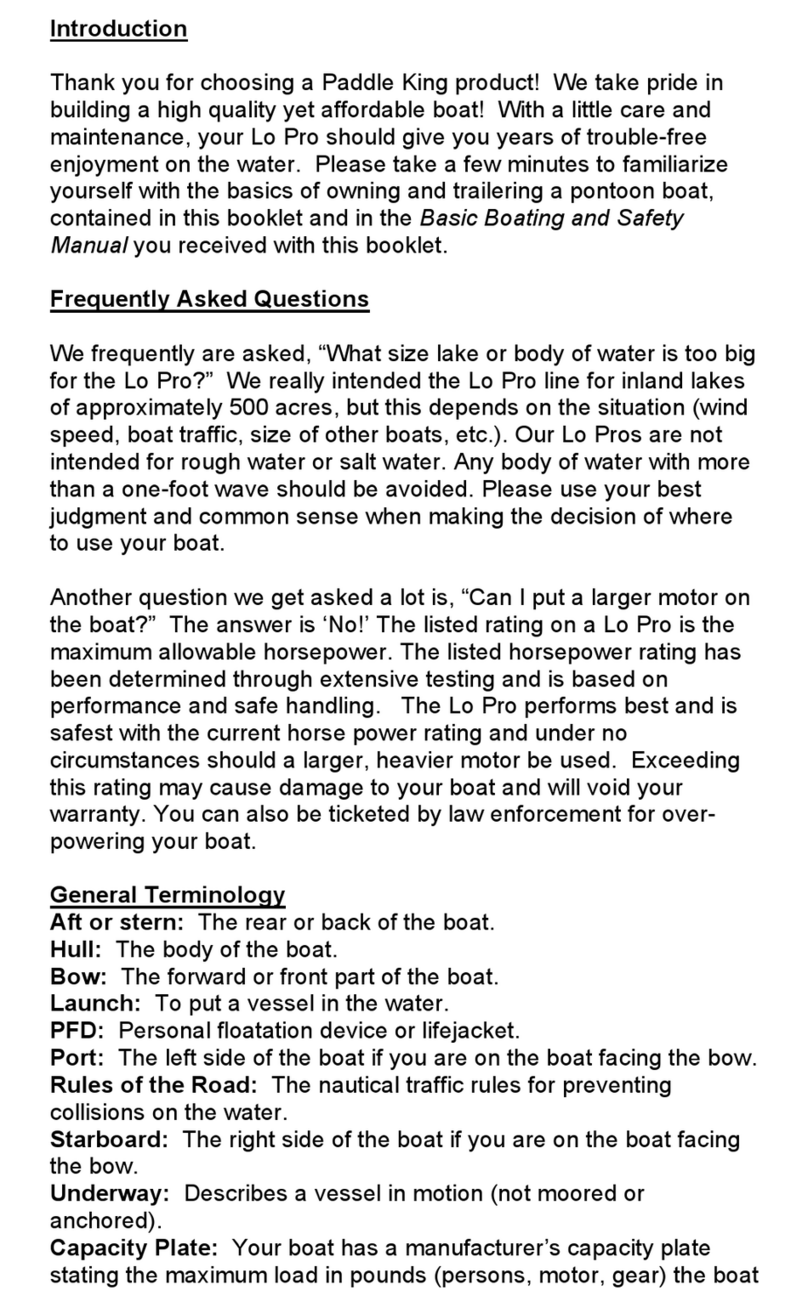
record of this number in a safe place so that if your boat is stolen, you can report this number to the local authorities
and your insurance agent.
Registration: All boats that have an engine or motor and are operated on navigable waters of the United States
must be registered in the owner’s state. Contact your local Secretary of State office for requirements.
Service/Maintenance Record: This is a good idea to keep a record on any work or maintenance that is done on the
boat or engine. Should you decide to sell your boat, it is also a good way to demonstrate that the boat and engine
have been well taken care of.
Warranty: Your new Paddle King boat is backed by a limited warranty. The complete warranty is printed in the
back of this booklet. It is the dealer’s responsibility to go over the terms of the warranty. It is the owner’s
responsibility to fill in the warranty registration card (which should have been provided to you with your boat) and
send it in within 30 days of purchase (send it in even it if it past 30 days!). By sending in the card, you are indicating
that you are aware of the terms and conditions of the warranty. Warranties are not transferable to a second owner.
Equipment Manufacturer Manuals: Paddle King purchases various equipment and components from other
manufacturers for your boat which carry their own manufacturer’s warranty, such as the motor. Any warranty
registration cards are in your owner’s packet. Please fill out these cards and mail them to the appropriate
manufacturer to validate the warranty.
Insurance: The owner of the boat is legally responsible for any damages or injuries caused by the boat. This is true
in most states even if someone else is operating the boat when an accident happens. You should carry adequate
personal liability and property damage insurance on your boat, just as you do on your automobile. This will also
protect your investment against damage or theft.
Disposal of Garbage: Plastic refuse can kill fish and marine wildlife and can damage propellers and water intakes.
The U.S. Coast Guard regulations completely prohibit the dumping of plastic refuse or other garbage mixed with
plastic anywhere.
Discharge of Oil: The Federal Water Pollution Control Act prohibits the discharge of oil or oily waste into or upon
the navigable waters of the United States or the waters of the contiguous zone if such discharge causes a film or
sheen upon or a discoloration of the surface of the water or causes a sludge or emulsion beneath the surface of the
water. Violators are subject to penalties of $5000 or more.
II. Systems and Components
Battery: If your boat has a gas-powered motor, the battery was supplied by your dealer or yourself. (If you have a
rechargeable battery and a trolling motor, please refer to the owner’s manual that came with the motor and battery.)
Inspect the battery for cleanliness and tight connections. Be sure that the battery compartment is well-ventilated. If
you need to replace a battery, install the same type as originally supplied with your boat. Warning: Batteries
contain sulfuric acid and can cause severe personal injury if mishandled. Avoid contact with eyes, skin or
clothing. In case of contact, flush with water at least 15 minutes. If swallowed, drink large quantities of water or
milk. Follow with Milk of Magnesia, beaten egg or vegetable oil. Get medical help immediately!
If the starting battery is discharged, you can jump start the boat’s engine. The battery cables do not need to be
removed. Be sure to connect like terminals (for example, positive to positive). The last cable to be connected
should be the negative cable of the charged battery. When you install the battery, battery connections must be
made properly. Attach the positive cable to the positive (+) terminal. Then, attach the negative battery cable to the
negative (-) terminal on the battery.
Charging the Battery: Warning: During charging, batteries produce gases which can explode. Explosion can
shatter the battery. Battery acid can cause severe personal injury such as blindness. Keep flame, spark, and
smoking materials away from battery while charging. Charge battery in a well-ventilated area. Batteries produce
hydrogen and oxygen gases when they are being charged. These explosive gases escape through the vent/fill
caps and may form an explosive atmosphere around the battery if ventilation is poor. This gas may remain around




























